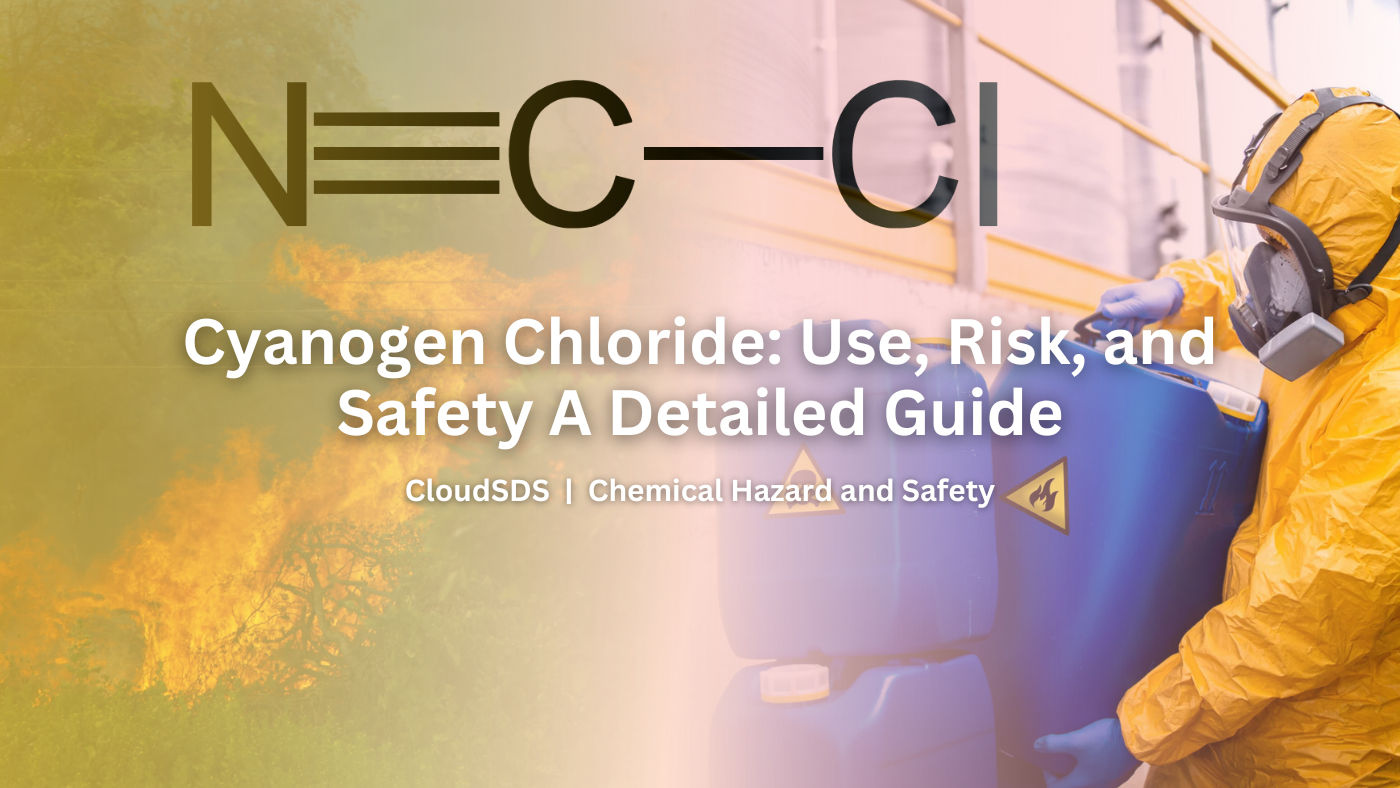Don’t let its unassuming name fool you; Cyanogen Chloride (CNCl) is a seriously potent chemical heavyweight, notorious for its:
- Specific industrial applications
- Extreme toxicity, and
- The rigorous safety protocols it demands
While it finds niche uses as a fumigant or as a precursor in organic synthesis, its dark past as a chemical warfare agent highlights its inherent danger, making it far more than just another industrial compound. This highly volatile substance is a fast-acting toxin that, even with minimal exposure, can rapidly cause severe health issues, including:
- Respiratory distress
- Pulmonary edema
- Convulsions, and
- Proven fatal by attacking the central nervous and cardiovascular systems
Consequently, handling CNCl demands uncompromising safety:
- Strict containment
- Advanced ventilation
- Comprehensive personal protective equipment
The PPE requirement includes specialized respirators and chemical-resistant suits, which are non-negotiable to prevent catastrophic exposure. In short, while Cyanogen Chloride might power some crucial industrial processes, its immense danger means absolute vigilance and strict adherence to safety protocols aren’t just recommended, they’re life-saving mandates.
Cyanogen Chloride: Recommended Usage, Hazards and Safety Measures
As stated before, Cyanogen Chloride (ClCN) is quite a volatile and toxic chemical utilized mostly in chemical synthesis and fumigation. Because of its high toxicity and ability to cause fatal systemic damage, severe engineering controls, personal protective equipment (PPE), and emergency response plans are needed to avoid exposure and respond to incidents effectively.
-
Introduction
Cyanogen chloride (informally abbreviated CK) is an inorganic, triatomic pseudohalogen with the molecular formula ClCN. In its gaseous state above 12.8 °C, it is a colourless gas with a sharp, pungent odour; below 12.8 °C, it is a liquid. Historically tested as a chemical warfare agent, CK is currently strictly controlled under Schedule 3 of the Chemical Weapons Convention and all production must be declared to the OPCW.
-
Physical Properties and Chemistry
Cyanogen chloride is a linear molecule (Cl–C≡N) with a molecular weight of 61.5 g/mol. Boiling point is 12.7 °C and the freezing point is –6 °C. CK has moderate solubility in water (7% w/v) and hydrolyzes slowly to cyanate and chloride ions:
ClCN+H2O→OCN−+Cl−+2H+ClCN+H2O→OCN−+Cl−+2H+
Decomposes under acid-catalyzed trimerization to cyanuric chloride and slowly reacts with water to give hydrogen cyanide.
-
Applications and Usage
- Chemical Synthesis: CK is a sulfonyl cyanide and chlorosulfonyl isocyanate precursor, which are valuable organic synthesis reagents.
- Fumigation: Used in controlled silo, ship, and store fumigation because of its gaseous penetration properties.
- Industrial Processes: Used in the manufacturing of synthetic rubber, metal cleaning compounds, and as an intermediate in the production of other specialty chemicals.
-
Toxicity and Health Hazards
Cyanogen chloride is classified as a blood agent, interfering with cellular oxygen utilization. Its toxicological profile includes:
Acute poisoning by CK results in headache, dizziness, confusion, convulsions, and eventually respiratory and cardiovascular collapse. The odor threshold (~1 ppm) is not a reliable warning owing to the fast rate of symptom onset and olfactory fatigue.
-
Occupational Exposure Limits
- NIOSH REL: 0.3 ppm (0.6 mg/m³) ceiling concentration; not to be exceeded at any time
- ACGIH TLV: 0.3 ppm ceiling
- OSHA PEL: None; see Appendix G for information
Due to its acute toxicity, any measurable CK concentration requires prompt mitigation.
-
Safety Measures and Controls
6.1 Engineering Controls
- Enclose all processes involving CK handling
- Provide local exhaust ventilation at the point of release
- Ensure negative-pressure containment of storage and transfer containers
6.2 Personal Protective Equipment
- Respiratory Protection: Positive-pressure full-facepiece supplied-air respirator or SCBA for unidentified concentrations.
- Skin/Eye Protection: Permeable chemical-resistant suit, gloves, and splash-resistant goggles or face shield.
- Hygiene Practices: Restrict eating, drinking, smoking in CK areas; enforce handwashing and decontamination showering.
6.3 Storage and Handling
- Store in fireproof rooms with good ventilation away from water sources to avoid hydrolysis
- Use corrosion-resistant containers equipped with pressure-relief devices
- Segregate from incompatible substances (strong alkalis, ammonia, alcohols, strong acids)
-
Environmental Impact and Regulations
CK can be generated as a by-product during chlorination or chloramination of waters containing cyanide. Normal concentrations in finished water are <10 µg/L, with higher concentrations in chloraminated systems (1.6 µg/L). Because of its volatility (Henry’s Law constant: 2.48 kPa·m³/mol), CK easily off-gases, decreasing persistence but increasing inhalation hazards.
Regulatory Status:
- Issued as a hazardous material by DOT (UN 1589 PIH) and EPA
- Schedule 3 CWC: Compulsory reporting of production and transfers
-
Emergency First Aid and Response
8.1 Spill and Fire
- Evacuate and ventilate area; do not use water streams on liquid.
- Extinguish nearby fires using dry chemical, CO₂, or foam; cool containers with water spray from a safe distance.
8.2 First Aid Procedures
- Inhalation: Remove victim to fresh air; if breathing stops, institute artificial respiration; give oxygen and obtain medical help at once.
- Skin Contact: Remove soiled clothing; flush skin with water for 15 minutes or longer; treat frostbite if involved.
- Eye Contact: Irrigate eyes with water for 15 minutes, raising eyelids; remove contact lenses, if possible, to do so; obtain ophthalmologic consultation.
- Ingestion: Do not attempt to induce vomiting; rinse mouth; offer respiratory assistance and emergency medical treatment.
8.3 Medical Monitoring
- Perform baseline and routine chest X-rays and pulmonary function tests for employees
- Closely monitor for late onset of pulmonary edema; symptoms can occur several hours after exposure
Conclusion
Cyanogen chloride’s value in chemical synthesis and fumigation is negated by its acute and chronic harmful health effects. Successful risk management requires effective engineering controls, thorough PPE practices, and reliable emergency response. Compliance with occupational limits and mandatory reporting prevents mishaps and ensures environmental release and human contact are kept to a bare minimum.


Leave A Comment